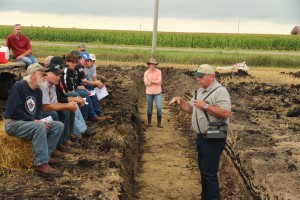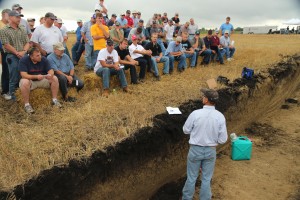
Dave Franzen, NDSU, and Marla Riekman, MAFRA, in Winnepeg, Manitoba, offer the latest research findings about medium tillage techniques, including strip tillage and banding fertilizer.
written by Jonathan Eisenthal
About 250 farmers gathered at a farm field seven miles south of Appleton in Lac qui Parle County to see demonstrations and hear information covering the entire spectrum of tillage, from ‘biological tillage’ (letting earthworms and tillage radishes do the heavy lifting) to moldboard plowing — the most invasive technique, but still a useful tool to be applied sparingly, according to the experts.
Farmer Jeff Olson generously offered his field for the demonstrations.
“There’s new types of (tillage) equipment coming out all the time,” said Adam Birr, research director for the Minnesota Corn Growers Association. “There are a lot of questions about the differences in the equipment. You’re seeing with the numbers here today, certainly the interest is there.”
University of Minnesota Extension tillage expert Jodi DeJong-Hughes orchestrated the daylong event, which included four pits to show the effects of the various tillage techniques. Experts in shallow, medium, deep and no-till agriculture spoke.
In addition, an expert with Rx Ag Solutions demonstrated the use of a drone for scouting fields. This is considered a developing science where crop consultants hope to use video and photography from above, recorded throughout the growing season, to assess nutrient needs, get a jump on pests and weed outbreaks, and otherwise improve crops in a timely way.
Francisco Arriaga of the University of Wisconsin discussed shallow tillage techniques, spanning 0-4 inch depth, and how farm operators succeed with these techniques when it comes to some trickier

Hal Weiser, of North Dakota Natural Resources Conservation Service, spoke about the benefits of ‘biological tillage’ — using cover crops like tillage radish, which have deep tap roots, to create pores and structure, and add organic matter and biological activity to soils used in crop production.
aspects like fertilizer incorporation, seedbed preparation and handling residue. He took his audience through vertical till, field cultivators, and soil finishers.
Medium tillage comprises the most prevalent range of cultivation techniques in crop production today. At the medium depth demonstration pit, the experts demonstrated a chisel plow set up with three different sets of points, as well as a strip till machine with various coulters and shanks mounted on it. Marla Riekman from MAFRI in Winnipeg offered information about how much nitrogen loss is incurred with medium tillage techniques. Dave Franzen from NDSU focused on band versus broadcast fertilization when the soil is turned to down to the 6-10 inch range.
Franzen said banding gets a better response than broadcasting when it comes to starter fertilizer, placed at the same time as the seed (but always at least two inches away from it). Deep banded versus fertilizer spread on the surface, when it’s just nitrogen, tends to be a wash. He suggested that if you were banding, and including P&K along with the nitrogen, you might come out ahead.
Deep tillage remains an important option, though it can result in soil compaction due to loss of structure.
“Structure is the best defense our soil has against compaction,” DeJong-Hughes said. “The aggregated soil particles act as “mini-columns” in the soil that help support the weight of equipment. Tillage destroys the structure and introduces air into the soil – and air has no load bearing capacity.”
Hal Weiser from North Dakota Natural Resource & Conservation Service showed off the deep layer of black soil left behind by eons of tall prairie grass, and talked about ways to rebuild soil health where tillage had disrupted structure and biological activity. Porosity — the air pockets created by well-structured soil — allows for both rapid water infiltration and copious water storage, as well as better yield capacity for crops.
Various cover crops, with the deep tap roots creating vertical spaces in the soil profile, are a biological alternative to steel tillage, he said. He made a plea for rotations, saying that even including alfalfa in a corn-bean rotation offers many of the benefits of ‘biological tillage.’
Here is a short video that gives a flavor of the various talks and demonstrations.

